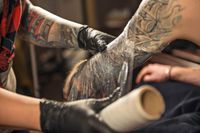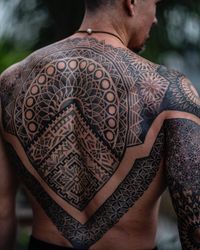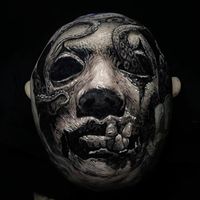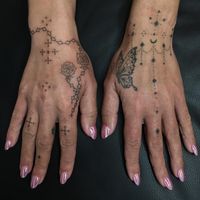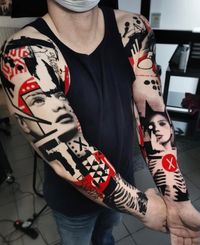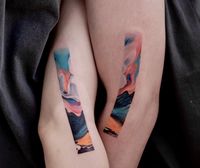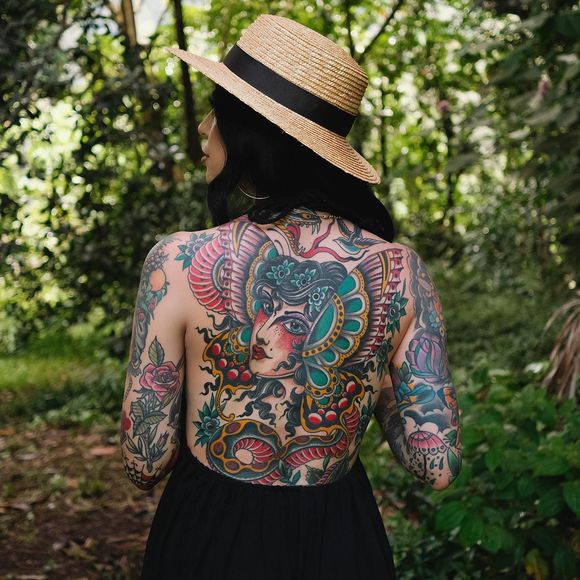
Tattoo Aftercare: How To Care For Your New Tattoo
In this article, we discuss some important steps in tattoo aftercare to ensure a quick and easy healing process for your new tattoo.
So you’ve got a new tattoo… welcome to the club!
As a collector, you need to be aware of a few things that can turn a beautiful work of art into a disappointing mess. The first week of healing is critical to how your tattoo will look for the rest of its life, so let’s have a look on how to take care of your new permanent accessory to have it looking great for years to come…
- Keep the initial bandage on for a minimum of two hours.
- After removing your bandage, you should gently cleanse your new tattoo with an antibacterial, fragrance-free soap (we like Dr. Bronner’s Hemp Baby Unscented, Pure-Castile Soap) and hot water. The hot water may cause temporary mild stinging, but will aid in opening pores for maximum cleansing.
- For the next 2-3 weeks, opt for a shower instead of submerging your new piece in the bath. Any standing water, especially bathwater, can introduce icky bacteria into your tattoo, so best to just avoid it all together.
- Wash your tattoo 1-2 times a day for the first few days, ESPECIALLY if you notice any oozing.
- Scabbing, flaking and peeling are all normal parts of the healing process. Do not pick or peel your scabs! If your skin is feeling particularly dry or itchy, you can introduce some moisture in the form of Coconut Oil or any non-fragrance lotion but do not over-moisturize.
- Do not use sunscreen on your tattoo while healing. If you must be in the sun, cover your new piece with clothing, and keep it out of direct sunlight.
Which products should one use for tattoo aftercare?
Your new tattoo needs to breathe to promote the healing process — which is why most professional tattoo artists will recommend lotions, butters, or natural oils free of synthetic chemicals, ointments and fragrances that often clog and suffocate the pores and act as irritants to broken skin. The more organic and natural, the better for your tattoo. This brings us to our personal favorite healing method…
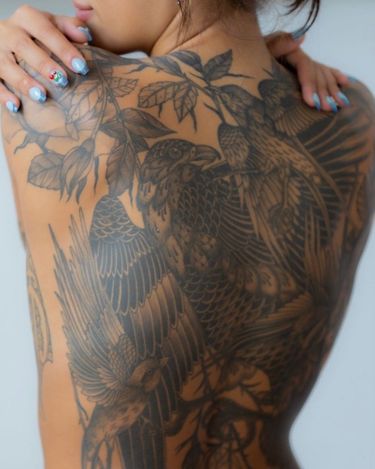
Naturally antibacterial, antifungal, anticarcinogenic, antimicrobial, anti-inflammatory and free of synthetic chemicals (unlike most ingredients found on drugstore shelves) Coconut Oil has become an increasingly popular choice of aftercare for all skin types, especially those with sensitive skin.
When applied, coconut oil forms a layer which aids in the protection from external bacteria, fungi, parasites, and dust. Its natural lipids speed up the healing process by repairing tissues damaged by the process of tattooing.
In the market for coconut oil — there’s a specific kind we want to look for. Unrefined, Virgin coconut oil is superior to the refined type as it is the most natural and nutrient dense, free from heat and chemical processing.
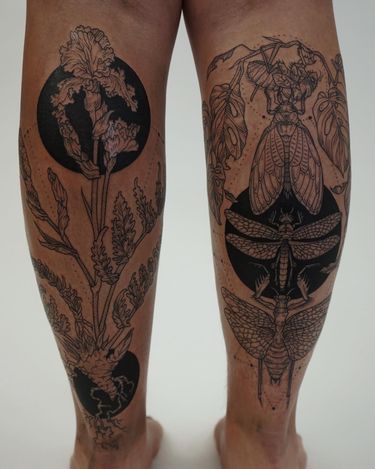
The process of tattooing impedes our skin’s natural production of oil, which is why it is important to moisturize your new tattoo on a semi-regular basis. There’s not an exact science to the amount of times you should be applying your aftercare. No matter what, it’s best to listen to your body. Whenever your tattoo is feeling particularly parched, stretched, or itchy — you can rub on a small amount of coconut oil. Keep in mind that coconut oil will take a bit longer to absorb, and a little goes a long way.
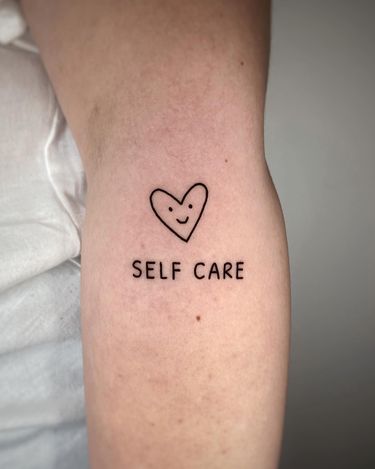
What should we avoid in the process of tattoo aftercare?
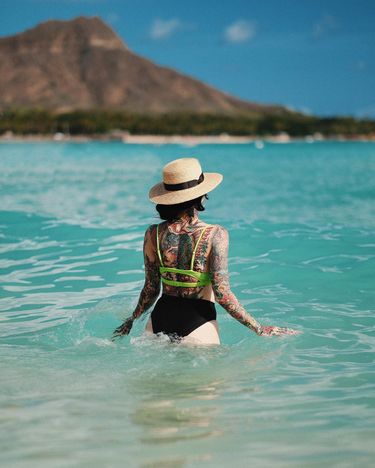
Direct sunlight & sunscreen
Sunblock and sunscreens are typically not formulated to protect wounds like a fresh tattoo. You will feel your new tattoo burning if it’s exposed to sunlight. If you must be out in the sun, keep it completely covered with clothing at all times.
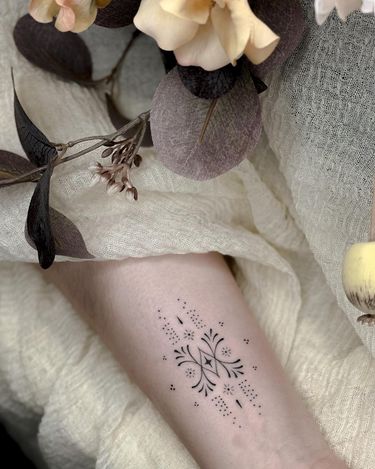
Tight-fitting clothing
When clothing and fabric abrade against your new tattoo, you run the risk of agitating the healing process. The least amount of contact with fabric is usually the best call while healing a new tattoo. Loose-fitting clothing should be worn around the area for a week minimum.

Sleeping on top of your tattoo
While in the healing phase, it is common for your tattoo to seep excess plasma, fluid, and ink — which may stick to sheets, blankets, or clothing. If you can sleep with your tattoo exposed, that would be best. To be safe, you can place a clean thin towel between you and the sheets. If upon waking you notice your tattoo is stuck to fabric, this is no cause for alarm. Don’t peel it off! Instead, take the fabric with you to the shower and wet it off with cool or lukewarm water.

Picking, scrubbing & scratching…
Scabbing is a very normal part of the tattoo healing process, and you may be tempted to accelerate that process by picking off unwanted flakes and peely-parts.
Don’t pick it!
Don’t scrub it either. Scabbing will typically be the same color as the pigment that was used. If you pick or scrub your scab, you risk pulling out the color or causing hypertrophic scarring of your tattoo. Let the tattoo heal by itself. Patience is a virtue.
Baths & standing water
Opt for showers instead of baths for 2-3 weeks as submerging a new tattoo in standing water may expose open skin to unwanted bacteria. This means no baths, pools, jacuzzis, lakes, ponds or quick dips in the ocean.

Symptoms to be aware of with your new tattoo include:
Some symptoms might raise concerns when it comes to your new tattoo. You don’t have to be worried about every single signal your body emits, but a few of them are worth talking about here.
If you’ve noticed a sudden outbreak of pimples around your tattoo, chances are you’ve over moisturized. Dial back on the oil/lotion and try to maintain a moisture level even with the rest of your body.
Professional tattoo artists do everything possible to ensure safe tattooing practices. However, they are not medical professionals. Contact your doctor immediately if the following symptoms arise when you’ve gotten a new tattoo:
- Severe pain or swelling
- Prolonged oozing of plasma with or without color
- Thick, hard scabs that are bleeding red blood
So, there you have it. By following this aftercare advice your brand new tattoo will soon mature into a phenomenally healed tattoo. Admittedly this is a task, but considering that you’re going to have that same tattoo for the rest of your life, what does it actually mean that you have to pay close attention to the aftercare for a couple of weeks? Good luck!
Cover image via @annaxmeliani

